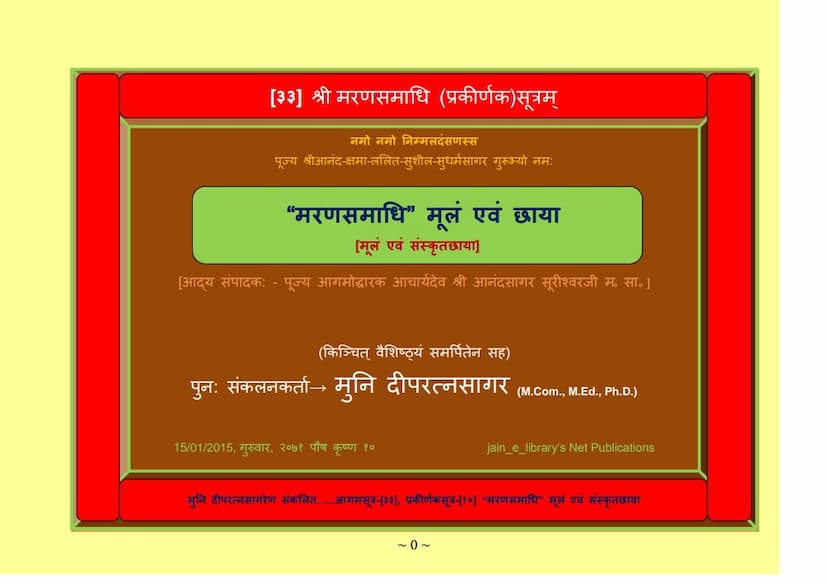Aagam 33 MARAN SAMAADHI Moolam Evam Chhaayaa
Added to library: September 1, 2025

Summary
Here's a comprehensive summary of the Jain text "Marana Samadhi Moolam evam Chhaayaa" (Aagam 33) based on the provided pages:
Book Title: Marana Samadhi Moolam evam Chhaayaa (Agam 33 Prakirnak Sutra 10) Author: Muni Deepratnasagar (Compiler) Original Editor: Acharya Shri Anandasagar Surishwarji Maharaj Saheb Publisher: Deepratnasagar (with reference to Shri Agamoday Samiti) Catalog Link: https://jainqq.org/explore/004133/1
Core Subject:
This text is the tenth Prakirnak (miscellaneous chapter) within the Agam literature, specifically identified as Agam 33, focusing on Marana Samadhi (Peaceful Death). It delves into the nature, methods, and importance of achieving a state of equanimity and spiritual readiness during the process of death.
Content Overview:
The book presents the original Prakrit text (Moolam) of the Marana Samadhi sutra, accompanied by a Sanskrit commentary (Chhaayaa) and explanations. The compilation is by Muni Deepratnasagar, who also acknowledges the original editing by Acharya Anandasagar Surishwarji. The text covers a wide range of topics related to a dignified and spiritually beneficial death, emphasizing the Jain principles of detachment, equanimity, and spiritual practice.
Key Themes and Topics Covered:
- The Nature of Death (Marana Swaroopam): The text discusses the various stages and types of death, highlighting the significance of intentional and conscious departure from the body, rather than accidental or ignorant passing.
- Methods for Achieving Marana Samadhi:
- Aaradhana (Worship/Devotion): Emphasizes devotion to the Jinas, the Siddhas, the Acharyas, the Sangha, and the scriptures as a means to spiritual well-being, which extends to the time of death.
- Tapas (Austerities): Details various forms of austerities, both internal and external, as a way to purify the self and prepare for a peaceful death. This includes fasting, reduced intake, introspection, and control over senses and passions.
- Alochana (Confession/Repentance): Stresses the importance of confessing and repenting for past transgressions, especially those related to the vows and practices, before death. This process is crucial for purging inner impurities.
- Samlehana (Controlled Fasting/Gradual Reduction): This is a significant theme, describing the practice of gradually reducing intake of food and water while engaging in spiritual practices to prepare the body and mind for death. It emphasizes the importance of the right intention and detachment from the body.
- Pandra Maranam (Wise Death): The text distinguishes between a "wise" or "learned" death (Pandita Maranam) and other forms of death. Pandita Maranam is characterized by conscious awareness, spiritual fortitude, and detachment.
- The Importance of the Five Mahavratas (Great Vows): The text highlights the preservation and adherence to the five great vows (non-violence, truthfulness, non-stealing, celibacy/chastity, and non-possession) as foundational for achieving a good death.
- The Role of Knowledge (Jnana) and Conduct (Charitra): The text stresses that true liberation and a peaceful death are achieved through the combination of right knowledge and right conduct.
- The Significance of Faith (Samyaktva): Cultivating strong faith in the Jain principles and teachings is presented as crucial for a serene end.
- The Twelve Bhavanas (Meditations): The text discusses twelve important meditations or contemplations that aid in cultivating detachment, equanimity, and spiritual understanding, essential for a peaceful death. These include contemplations on impermanence, suffering, the nature of the self and non-self, impurity, karma, and the path to liberation.
- Prakirnak Sutras on Various Aspects: The sutras cover detailed aspects like the conduct of the Acharyas, the importance of the guru-shishya relationship, the process of confession and penance, various types of austerities, the nature of suffering in different life forms and realms, and the ultimate goal of liberation.
- Examples and Stories: The text seems to include illustrative examples and stories of monks and individuals who achieved Marana Samadhi through their devotion, austerities, and wisdom, serving as inspiration.
Compiler's Note (Muni Deepratnasagar):
Muni Deepratnasagar explains his motivation for re-compiling this text. He notes that the original version was published in 1927 by Shri Agamoday Samiti, edited by Acharya Anandasagar Surishwarji. He expresses concern about later editions that either credited themselves solely or omitted the original editor and publisher. His effort aims to preserve the authenticity and provide a more accessible version through scanning and a specialized format, making the ancient teachings available to a wider audience, particularly through digital means (jain_e_library.org).
Overall Purpose:
The primary purpose of "Marana Samadhi Moolam evam Chhaayaa" is to guide Jain ascetics and lay followers on how to approach death with spiritual consciousness and equanimity. It serves as a guide to understanding the true nature of existence, the cycle of birth and death, and the means to transcend suffering and achieve ultimate liberation through a peaceful and determined spiritual end. The text underscores that a "wise death" is not accidental but a result of continuous spiritual practice, detachment, and unwavering faith in Jain principles.